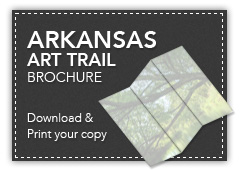Interested in architecture? Learn more about architecture in Arkansas and plan on visiting the Top Trail Sites for Architecture on the Arkansas Art Trail.
Crystal Bridges Museum of American Art by Moshe Safdie.
An apprentice of Louis Kahn, Safdie’s works are immediately recognizable. Meaningful spaces created by curving architecture that complement the essence of their setting and culture. Crystal Bridges exemplifies Safdie’s principle of responding to the essence of place even bearing its name for the natural creek it spans. See the layout of Crystal Bridges and read about the challenges of constructing these cable roofed buildings and the hurdles of completing this project while continuing to build responsibly, treading as lightly as possible on the landscape. The Crystal Bridges complex pays deference to the natural setting through organic shapes, fantastic views, and native materials used for its construction and is architecture with a purpose. Visit and discover for yourself how Crystal Bridges Museum of American Art’s collection echoes themes of American landscape and life. View an interview with Moshe Safdie on the modern issues in architecture and how he is working to shape the public realm and humanize megascale building.
Thorncrown Chapel by E. Fay Jones.
E. Fay Jones was an apprentice of Frank Lloyd Wright and Bruce Goff. Jones created organic architecture from simple materials: wood, stone, glass, and steel and much of Jones work can be found throughout northwest Arkansas. It can be said that the touchstone of his architectural accomplishments is Thorncrown Chapel, a place of “gentle beauty and quiet dignity that celebrates the land and embraces the American Spirit.” Jones received the highest honor awarded by the American Institute of Architects, the Gold Medal, for “humble, original, intelligent, and uncompromising [architecture].” (Quotes taken from the AIA Gold Medal citation presented to Fay Jones. Now part of the Special Collections Division of the University of Arkansas Libraries.)
Thorncrown was awarded the American Institute of Architecture’s Design of the Year Award (1981) and the American Institute of Architecture’s Design of the Decade Award (1980). It is #4 of the members of the American Institute of Architects Top Buildings of the Twentieth Century and won the AIA Twenty-five Year Award for a design that has stood the test of time for more than 25 years (2006).
Tour organic architecture on the Arkansas Art Trail. Experience organic architecture for yourself at the Cottages at Crescent Park. The Cottages are designed by David McKee, apprentice of E. Fay Jones. McKee’s design philosophy is rooted in the principles of organic architecture as developed by Frank Lloyd Wright and E. Fay Jones.
1886 Crescent Hotel by Isaac S. Taylor.
The Crescent was one of America’s most luxurious resort hotels boasting eighteen inch thick walls of White River limestone quarried just miles from the site of the hotel. Surrounded by acres of pristine woodlands, the hotel sat on top of West Mountain overlooking the valley and town below. Read more about the history of the Crescent Hotel.
Isaac S. Taylor was the chief architect of the Largest World’s Fair ever held, the St. Louis Exposition in 1904. In the process he was charged with finishing one of the largest public parks in America, Forest Park. He was also a member and Fellow of the American Institute of Architects. Read more about the 1904 Worlds Fair and see photos of structures in the fair.
Victorian Vernacular-Architecture in Eureka Springs
Beginning in the late 1800’s, the machine age triggered the revival of traditional craftsmanship in building and the use of local materials which lead to the Queen Anne and Arts and Crafts style homes. Vernacular buildings inherently weave local traditions, building materials and skills into a recognizable form.
The town of Eureka Springs showcases Victorian vernacular with its many remaining historic structures. In fact, the whole town is on the National Register of Historic Places. Discover Arts and Crafts style elements in the 1905 Basin Park Hotel and Queen Anne residences on both sides of the historic loop. If you are downtown, just look up. Victorian homes are tucked into the mountainsides surrounding downtown Eureka Springs.
Photos that appear on the Arkansas Art Trail website were taken by local Eureka Springs artist Edward C. Robison. See more of his work at Sacred Earth Gallery. For cultural events on the Arkansas Art Trail, find us on Facebook.
FOLLOW THE ARKANSAS ART TRAIL… WHERE NATURE INSPIRES ART.










